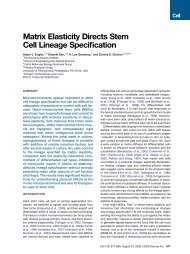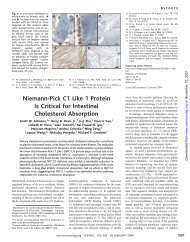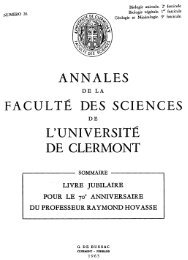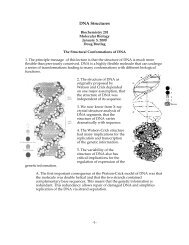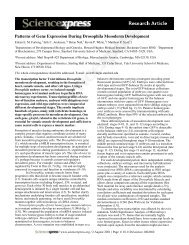Development of the Drosophila tracheal system occurs by a series of ...
Development of the Drosophila tracheal system occurs by a series of ...
Development of the Drosophila tracheal system occurs by a series of ...
You also want an ePaper? Increase the reach of your titles
YUMPU automatically turns print PDFs into web optimized ePapers that Google loves.
Tracheal branching morphogenesis139712). These are <strong>the</strong> primary branches. The cells that do not growout to form primary branches remain to form <strong>the</strong> transverse connective.Primary branches produce secondary branches at stage15. The first terminal branches form at stage 16 as continuations<strong>of</strong> secondary branches (Fig. 1I). In <strong>the</strong> larval period, <strong>the</strong>seramify into extensive arrays <strong>of</strong> terminal branches (tracheoles)that cover <strong>the</strong> target tissues (see Fig. 4C). The pattern <strong>of</strong> primaryand secondary branching is stereotyped, although <strong>the</strong>re is someembryo-to-embryo variability in <strong>the</strong> exact number and position<strong>of</strong> secondary branches. In contrast, <strong>the</strong> pattern <strong>of</strong> terminalbranching is highly variable and believed to be dependent on<strong>the</strong> oxygen needs <strong>of</strong> <strong>the</strong> target tissues (Rühle, 1932).Several primary and secondary branches in each hemisegmentdo not complete this typical branching sequence. Theycease branching and grow towards <strong>tracheal</strong> branches fromneighboring hemisegments, to which <strong>the</strong>y fuse to interconnect<strong>the</strong> <strong>tracheal</strong> network. The dorsal trunk anterior and posteriorfuse with <strong>the</strong>ir partners at stage 14 to form <strong>the</strong> dorsal trunk(Fig. 1I, arrow). Similarly, three secondary branches in Tr5fuse with <strong>the</strong>ir partners to connect <strong>the</strong> lateral trunk and to forma dorsal anastomosis that connects <strong>the</strong> right and left sides <strong>of</strong><strong>the</strong> <strong>tracheal</strong> network (Fig 1I, arrowheads).The branching process takes ~10 hours, from <strong>the</strong> middle to<strong>the</strong> end <strong>of</strong> embryogenesis, although terminal branchingcontinues in <strong>the</strong> larval period. Throughout most <strong>of</strong> embryogenesis,<strong>the</strong> <strong>tracheal</strong> <strong>system</strong> is filled with liquid. About twohours before hatching, <strong>the</strong> liquid is rapidly cleared from <strong>the</strong>tubes and <strong>the</strong>y become functional for respiration.Cell number and distribution in <strong>the</strong> developing<strong>tracheal</strong> <strong>system</strong>To elucidate <strong>the</strong> cellular basis <strong>of</strong> <strong>tracheal</strong> branching, we firstdetermined <strong>the</strong> number and positions <strong>of</strong> <strong>tracheal</strong> cells during<strong>the</strong> branching process with <strong>the</strong> aid <strong>of</strong> enhancer trap strains inwhich <strong>the</strong> marker is expressed in all <strong>tracheal</strong> cell nuclei. Therewere ~80 cells in Tr5. These were typically distributed among<strong>the</strong> different branches as shown in Fig. 2. A small and characteristicnumber <strong>of</strong> cells formed each primary branch, although<strong>the</strong> exact number and positions <strong>of</strong> cells were not rigidly prescribed(see Fig. 2 legend). Each cell has been assigned a nameaccording to its typical position at stage 16 (Fig. 2).The total number <strong>of</strong> <strong>tracheal</strong> cells did not increase as <strong>the</strong>primary branches grew and <strong>the</strong> secondary branches formed andextended throughout <strong>the</strong> embryo (Fig. 2 legend). Consistentwith this, no <strong>tracheal</strong> DNA syn<strong>the</strong>sis was detected <strong>by</strong> BrdUlabeling after stage 11 (see Methods) and no mitotic figureshave been observed in <strong>the</strong> <strong>tracheal</strong> <strong>system</strong> during <strong>the</strong> sameperiod (Poulson, 1950; Campos-Ortega and Hartenstein,1985). We also did not detect any dying or dead cells in <strong>the</strong>developing embryonic <strong>tracheal</strong> <strong>system</strong> <strong>by</strong> in situ nick translation<strong>of</strong> DNA ends (see Methods). Thus, <strong>the</strong> dramatic growth<strong>of</strong> <strong>the</strong> <strong>tracheal</strong> network does not involve cell proliferation,death or <strong>the</strong> egression or ingression <strong>of</strong> cells. Ra<strong>the</strong>r, newbranches form <strong>by</strong> migration and rearrangement <strong>of</strong> <strong>tracheal</strong> cellsand <strong>by</strong> cell elongation.Multicellular primary branches form <strong>by</strong> cellmigration and intercalationPrimary branches arise <strong>by</strong> migration <strong>of</strong> small groups <strong>of</strong><strong>tracheal</strong> cells that organize <strong>the</strong>mselves into tubes as <strong>the</strong>ymigrate. In <strong>the</strong> first stage <strong>of</strong> this process, <strong>tracheal</strong> cells migrateout and branches grow as o<strong>the</strong>r <strong>tracheal</strong> cells follow <strong>the</strong>m. In<strong>the</strong> second stage, no additional cells enter <strong>the</strong> branches, andbranches grow <strong>by</strong> cell elongation and intercalation.A close up view <strong>of</strong> development <strong>of</strong> <strong>the</strong> dorsal branch isshown in Fig. 3. Several <strong>tracheal</strong> cells migrate dorsally,forming a small bud at stage 12. These continue to movedorsally with o<strong>the</strong>r <strong>tracheal</strong> cells following, generally in pairs,forming a branch <strong>of</strong> ~6 cells and <strong>of</strong> relatively constant (2-cell)diameter <strong>by</strong> <strong>the</strong> beginning <strong>of</strong> stage 13. This completes <strong>the</strong> firststage <strong>of</strong> dorsal branch formation. Up to this point, <strong>the</strong> cells in<strong>the</strong> new branch all appear quite similar and are roughlycuboidal. No cellular processes protruding from <strong>the</strong> migratingcells are detectable <strong>by</strong> DIC optics and <strong>the</strong> cells have leng<strong>the</strong>nedlittle in <strong>the</strong> direction <strong>of</strong> outgrowth. Thus, <strong>the</strong>re does notappear to be any net deformative force on individual <strong>tracheal</strong>cells as <strong>the</strong>y form a dorsal branch.The o<strong>the</strong>r primary branches begin to form at <strong>the</strong> same timeand in a similar manner as <strong>the</strong> dorsal branch. Cells migrate outand form new branches <strong>of</strong> relatively constant, 2-cell diameter,although each primary branch grows to a distinct length andcontains a proportionately different number <strong>of</strong> cells (see Fig.2, stage 12). This indicates that <strong>the</strong> length <strong>of</strong> a primary branchis controlled independently <strong>of</strong> its diameter.The second stage <strong>of</strong> primary branch formation <strong>occurs</strong> over<strong>the</strong> next 2-3 hours, from stage 13 to 15. The branches continueto extend (Fig. 3C-E) but no additional cells are recruited into<strong>the</strong> branches. Instead, <strong>the</strong> cells in <strong>the</strong> branch elongate and intercalatefrom a side-<strong>by</strong>-side to an end-to-end arrangement. Thebranches become very narrow as <strong>the</strong>y grow, as if <strong>the</strong>y are beingstretched. One or two cells at <strong>the</strong> base <strong>of</strong> <strong>the</strong> dorsal branchappear to recede into <strong>the</strong> dorsal trunk during this time. Only<strong>the</strong> primary branches that form <strong>the</strong> dorsal trunk do not undergothis period <strong>of</strong> intercalative growth. The cells in <strong>the</strong>se branchesremain clustered and <strong>the</strong> branches stay short and fat as <strong>the</strong>yfuse with <strong>the</strong>ir partners.During <strong>the</strong> cell migrations and rearrangements describedabove that give rise to <strong>the</strong> primary branches, <strong>the</strong> migrating cellsorganize <strong>the</strong>mselves into tubular structures. Antibody stainsshow <strong>the</strong> presence <strong>of</strong> a lumen in all primary branches fromstage 11 onward (Fig. 1). The same result was also obtainedwhen <strong>the</strong> <strong>tracheal</strong> lumen was visualized in living embryos afterintroduction <strong>of</strong> fluorescent dyes <strong>by</strong> microinjection (seeMethods). In <strong>the</strong>se latter experiments, <strong>the</strong>re was no leakage <strong>of</strong>dye from <strong>the</strong> lumen during outgrowth, demonstrating that <strong>the</strong>tubes are closed and <strong>the</strong> integrity <strong>of</strong> <strong>the</strong> <strong>tracheal</strong> epi<strong>the</strong>lium ismaintained throughout <strong>the</strong> branching process.Secondary branches are formed <strong>by</strong> individual<strong>tracheal</strong> cellsA striking finding <strong>of</strong> <strong>the</strong> cellular analysis was that eachsecondary branch is formed <strong>by</strong> a single <strong>tracheal</strong> cell. Formation<strong>of</strong> <strong>the</strong> two secondary branches <strong>of</strong> <strong>the</strong> Tr5 dorsal branch isshown in Fig. 3D-F. At stage 13, <strong>the</strong> two cells at <strong>the</strong> end <strong>of</strong><strong>the</strong> dorsal branch, DB1 and DB2, are paired like <strong>the</strong> o<strong>the</strong>r cellsin <strong>the</strong> branch and indistinguishable from <strong>the</strong>m morphologically.However, as <strong>the</strong> o<strong>the</strong>r cells begin to elongate and intercalate,DB1 and DB2 initially remain paired (Fig. 3D), and<strong>the</strong>y develop broad cytoplasmic extensions. Subsequently <strong>the</strong>two cells begin to separate and grow in different directions(Fig. 3E), each forming a distinct secondary branch.
Tracheal branching morphogenesis1401Table 1. Examples <strong>of</strong> <strong>the</strong> earliest <strong>tracheal</strong> enhancer trapmarkers in each classExpressionStageclass and Map No. <strong>of</strong> β-galmarker name position isolates begins Notes Gene(A) GeneralTracheal-1 61B3-C1 1 10 (l) <strong>tracheal</strong>essTracheal-2 70C 1 11 (b), (m) breathlessTracheal-3 59F1-2 2 11/12Tracheal-4 38B 1 11/12 (c)Tracheal-5 90D1-2 & 1 11/12 (c)92C1-2Tracheal-6 94B-C 1 11/12 (b)(B) PantipPantip-1 94F1-2 1 12 (a), (n) pointedPantip-2 63D1-2 3 12Pantip-3 55A3-4 1 12 (a)Pantip-4 54F 1 13 (a),(c)Pantip-5 74B1-2 1 13Pantip-6 61F6-7 1 13Pantip-7 61D1-2 1 14/15(C) TerminalTerminal-1 60C5 1 13/14Terminal-2 26A5-6 1 13/14Terminal-3 56A-B 1 13/14Terminal-4 25F1-2 2 14/15Terminal-5 85D1-2 & 1 14/1594F1-2(D) FusionFusion-1 35D1-2 4 13 (d)Fusion-2 42C7-9 1 13 (d)Fusion-3 91D 2 13/14 (e), (f)Fusion-4 87C6-8 1 14 (f)(E) AntifusionAntifusion-1 71C-D 1 14 (g)Antifusion-2 83F1-2 1 14 (g)Antifusion-3 70C12-13 1 15 (g)(F) RegionalRegio-1 66D10-12 4 11/12 (i),(k)Regio-2 32F1-2 1 11/12 (i),(k), (o) spaltRegio-3 46F1-2 1 13 (i), (j), (k)Regio-4 60D1-2 1 13 (i), (j)(G) Branch-specificBranch-1 n.d. 1 13 (d), (k)Branch-2 30A3-5 1 13 (e), (h), (k)Branch-3 21C4- 5 1 13 (d), (e), (k)(H) ComplexComplex-1 33B8-12 1 13 (k)Complex-2 57B13-14 1 14 (k)(a) Some weak, general expression at earlier stages. (b) Not expressed inSB. (c) Later turns <strong>of</strong>f everywhere except terminal cells. (d) Expressed in SB.(e) Expressed in VB. (f) Expressed in GB2 cell. (g) General <strong>tracheal</strong>expression begins at stage 11; turns <strong>of</strong>f in fusion cells at stage indicated.(h) Expressed in DT fusion cells. (i) Expressed in dorsal region <strong>of</strong> <strong>tracheal</strong><strong>system</strong>. (j) Expressed in ventral region <strong>of</strong> <strong>tracheal</strong> <strong>system</strong>. (k) See Fig. 6.(l) Wilk et al., 1996. (m) Klambt et al., 1992. (n) Klambt, 1993. (o) Kuhnleinet al., 1994.which label <strong>the</strong> visceral branch, and Branch-3 which marksboth <strong>the</strong> spiracular and visceral branches (Fig. 6 and Table 1).There were also regional markers expressed in broaderdomains encompassing two or more contiguous primaryTable 2. Structures <strong>of</strong> 101 <strong>tracheal</strong> cell clonesDB clones: DB1,2; DB1,2,DT12,14; DB1,3,4,5; DB1,5; DB1,DT12;DB1,DT4,10,18; DB1,DT19; DB2,5,DT4,8; DB3,DT10; DB4,5 (2);DB4,DT9,12,14; DB5,DT16; DB5,DT7; DB5,DT6; DB5,LTa5,LTp1,7DT clones: DB1,2,DT12,14; DB1,DT4,10,18; DB1,DT19; DB2,4,DT4,8;DB3,DT10; DT4,DT9,12,14; DB5,DT7; DB5,DT16; DB1,DT12;DB5,DT6; DT6,8,16,19; DT5,7; DT5,9; DT5,11; DT16,17; DT9,TC3;DT4,6,10,TC7; DT2,19,TC2,4; DT13,TC1,2,LTa7; DT9,14,TC1,3;DT20,LTp6; DT18,19,20,TC6TC clones: DT9,TC3; DT2,19,TC2,4; DT4,6,10,TC7; DT18,19,20,TC6;DT9,14,TC1,3; DT13,TC1,2,LTa7; TC3,5,6,7; TC1,VB19; TC2,LTa4;TC6,7,8,SB1; TC5,7,LTp9,10; TC5,7; TC9,10,LTa7,8; TC7,10;TC7,9,LTa4,LTp9; TC8,LTa5; TC8,LTa1; TC9,LTa1,6,LTp6; TC9,LTa5(2); TC9,LTa4; TC10,LTa8,LTp7,8VB clones: TC2,VB19; VB17,18; VB17,LTa5,6,8; VB4,7; VB4,8,LTa1,5SB clones: TC6,7,8,SB1; SB7,LTP5; SB4,LTp10LTa clones: DB5,LTa5,LTp1,7; DT11,TC1,2,LTa7; TC2,LTa4;VB4,8,LTa1,5; VB17,LTa5,6,8; TC7,9,LTa4,LTp9; TC8,LTa5;TC8,LTa1; TC9,10,LTa7,8; TC9,LTa1,6,LTp6; TC9,LTa5 (2);TC10,LTa8,LTp7,8; LTa5,6,8,LTp10; LTa4,8; LTa6,7; LTa6,7,LTp10,11;LTa3,7; LTa4,5,6,7: LTa2,4,5,6; LTa5,6,LTp8,11; LTa4,6 (2);LTa2,4,6,LTp7; LTa6,LTp10 (2); LTa6,LTp9; LTa6,LTp7; LTa7,LTp6;LTa1,7,LTp5,6; LTa4,5 (2); LTa4,5,LTp1,7; LTa4,5,LTp2;LTa3,5,LTp9,10; LTa5,LTp7,8,9,10; LTa5,LTp7; LTa1,4 (2); LTa3,4;LTa2,4; LTa4,LTp3; LTa4,LTp1; LTa1,2; LTa1,5; LTa3,LTp1,2;LTa1,LTp4LTp clones: DB5,LTa5,LTp1,7; DT20,LTp6; SB7,LTp5; SB4,LTp10;TC7,9,LTa4,LTp9; TC9,LTa1,6,LTp6; TC10,LTa8,LTp7,8;LTa5,6,8,LTp10; LTp9,11; LTp7,8,10,11; LTp8,11; LTa6,7,LTp10,11;LTa5,6,LTp8,11; LTa3,5,LTp9,10; LTp1,2,8,9; LTp1,9;LTa5,LTp7,8,9,10; TC3,6,LTp9,10; LTa6,LTp10 (2); LTa6,LTp9; LTp7,8;LTp6,8; LTp3,8; LTp1,8; LTa6,LTp7; LTa5,LTp7; LTa2,4,6,LTp7;LTa4,5,LTp1,7; LTa1,LTp4; LTp1,3: LTa4,LTp3; LTa4,5,LTp2; LTp1,2(5); LTa3,LTp1,2; LTa4,LTp1Clones are separated <strong>by</strong> semicolons and cells within a clone are separated<strong>by</strong> commas (see Fig. 2 for cell nomenclature). Clones that contained cells in aparticular major branch (e.g. DB) are listed toge<strong>the</strong>r; clones with cells inmore than one major branch are listed more than once. All clones wereunique except for those followed <strong>by</strong> a number in paren<strong>the</strong>ses indicating <strong>the</strong>number <strong>of</strong> times a clone with that structure was observed.branches, such as Regio-1, Regio-2 and Regio-3 (Fig. 6).Branch-specific and regional markers might be involved inestablishing or maintaining <strong>the</strong> boundaries between branches,or in controlling <strong>the</strong> special character <strong>of</strong> each primary branchsuch as its size, direction <strong>of</strong> outgrowth and pattern <strong>of</strong>branching.A significant number <strong>of</strong> <strong>tracheal</strong> markers showed morecomplex patterns that did not correspond to any obvious aspect<strong>of</strong> <strong>tracheal</strong> morphology or function. Two examples are illustratedin Fig. 6 (Complex-1, Complex-2). These complexexpression patterns indicate that <strong>tracheal</strong> cells undergo a substantialdegree <strong>of</strong> diversification during branching, beyondwhat can currently be explained on morphological grounds.A clonal analysis demonstrates that branching fatesare not assigned to <strong>tracheal</strong> cells until after <strong>the</strong>irfinal divisionThe existence <strong>of</strong> distinct <strong>tracheal</strong> cell types and branches, aswell as <strong>the</strong> quite reproducible positions <strong>of</strong> cells withinbranches, raises two major questions about <strong>the</strong> lineal relations<strong>of</strong> cells in <strong>the</strong> <strong>tracheal</strong> <strong>system</strong>. First, are cells that populate particularbranches or regions <strong>of</strong> <strong>the</strong> <strong>tracheal</strong> tree or that sharesimilar branching fates related <strong>by</strong> lineage? Second, during <strong>the</strong>substantial migrations <strong>of</strong> <strong>the</strong> <strong>tracheal</strong> epi<strong>the</strong>lium that occurduring invagination and branch formation, do sibling cells
1402C. Samakovlis and o<strong>the</strong>rsVB, St 15 VB, St 16/17VB, LarvalA B CTCLT, St 16DDT, St 16EGBGB, St 16DB, St 16F G H I J KLumen Cell junctions Double Cells Cell junctions DoubleFig. 4. Unicellular secondary branches and subcellular terminal branches. (A) Terminal cells <strong>of</strong> a visceral branch in early stage 15. Terminalcells are clustered (bracket) but secondary branches have not formed. Terminal cell nuclei, brown (Terminal-1 marker). Lumen, black(mAb2A12). (B) Visceral branch terminal cells several hours later after <strong>the</strong> cells have separated and each has formed a separate secondarybranch (arrow). (C) A single visceral branch terminal cell several days later (third instar larva) after <strong>the</strong> cell has formed an extensive network <strong>of</strong>terminal branches on <strong>the</strong> gut. The image is a combined <strong>series</strong> <strong>of</strong> confocal optical sections, with <strong>tracheal</strong> lumen visualized under phase contrast,and <strong>tracheal</strong> and gut nuclei visualized <strong>by</strong> staining with propidium iodide (pseudocolored blue). The terminal cell nucleus (arrow) is located at<strong>the</strong> point where <strong>the</strong> secondary branch ramifies into over fifty terminal branches. (D) Two hemisegments <strong>of</strong> <strong>the</strong> lateral trunk at stage 16, doublestainedto show lumen (black, mAb2A12) and <strong>tracheal</strong> cell nuclei and cytoplasm (brown, Tracheal-1 marker). Most unicellular secondarybranches arise at growing ends <strong>of</strong> primary branches like <strong>the</strong> branches from LTa1, 2 and 3 cells (arrowheads), but o<strong>the</strong>rs like those fromLTp/GB10 cells arise internally (arrows). TC, transverse connective. GB, ganglionic branch. (E) Section <strong>of</strong> <strong>the</strong> dorsal trunk at stage 16 stainedwith Coracle antiserum, showing <strong>the</strong> characteristic strong labeling <strong>of</strong> cell junctions. Anterior is down in this panel. (F-H) Ganglionic branch atstage 16 double stained to show lumen (mAb2A12) and cell junctions (Coracle). A distinct seam <strong>of</strong> Coracle staining indicating an autocellularjunction extends down to <strong>the</strong> proximal edge <strong>of</strong> <strong>the</strong> terminal cell nucleus (arrow). Lumenal staining continues past <strong>the</strong> nucleus into <strong>the</strong> terminalbranch. Asterisks, GB1 (bottom) and GB2 (top) nuclei. Arrowhead, edge <strong>of</strong> nerve cord. (I-K) A late stage 16 dorsal branch <strong>of</strong> an embryocarrying <strong>the</strong> Tracheal-1 marker and double stained for β-galactosidase to show <strong>tracheal</strong> cells and Coracle to show cell junctions. The DB3, 4and 5 cells have intercalated; Coracle staining marks <strong>the</strong> autocellular junction along <strong>the</strong> length <strong>of</strong> each cell and <strong>the</strong> junctions between cells. Anautocellular junction is also seen in DB1 but ends at <strong>the</strong> nucleus (arrows), where terminal branching begins. Bars: A-D, 10 µm; E-K, 5 µm.remain toge<strong>the</strong>r or can <strong>the</strong>y separate and populate differentparts <strong>of</strong> <strong>the</strong> <strong>tracheal</strong> tree? To address <strong>the</strong>se questions, weanalyzed <strong>the</strong> structures <strong>of</strong> marked clones <strong>of</strong> <strong>tracheal</strong> cells.Random clones <strong>of</strong> embryonic cells expressing a lacZtransgene were generated <strong>by</strong> FLP-mediated recombination.Recombination was induced just before and during <strong>the</strong> last two<strong>tracheal</strong> cell divisions, generating clones containing two orfour cells. Clones were observed in embryos aged to stage 15or 16, when <strong>the</strong> final positions and fates <strong>of</strong> <strong>tracheal</strong> cells areclear (Table 2, Fig. 7).Analysis <strong>of</strong> <strong>the</strong> 101 identified clones revealed two results.First, <strong>the</strong>re were no consistent relationships in <strong>the</strong> finalpositions or ultimate fates <strong>of</strong> sibling cells, beyond <strong>the</strong> fact that<strong>the</strong>y tended to populate <strong>the</strong> same general region <strong>of</strong> <strong>the</strong> <strong>tracheal</strong>hemisegment. For example, in <strong>the</strong> seven clones that included<strong>the</strong> DB1 terminal cell (Fig. 7A-G), its siblings populateddifferent primary branches and none formed terminal branches,although all <strong>of</strong> <strong>the</strong> cells resided in dorsal positions in <strong>the</strong><strong>tracheal</strong> tree. Second, while <strong>tracheal</strong> cells tended to remainnear <strong>the</strong>ir siblings, many sibling cells separated from one
Tracheal branching morphogenesis140311 12 13 14 16 14, DBABDGeneralPantipC TerminalFusionano<strong>the</strong>r and some ended up widely dispersed in <strong>the</strong> <strong>tracheal</strong>tree (Fig. 7P-T). This demonstrates a substantial capacity forcells to move with respect to one ano<strong>the</strong>r within <strong>the</strong> <strong>tracheal</strong>epi<strong>the</strong>lium during development.The results show that at <strong>the</strong> time <strong>of</strong> clone marking, <strong>the</strong>movements <strong>of</strong> <strong>tracheal</strong> cells with respect to one ano<strong>the</strong>r, <strong>the</strong>primary branches that <strong>the</strong>y will occupy and <strong>the</strong>ir ultimate fateswith respect to secondary branching, terminal branching and152341 2Fig. 5. Expression patterns <strong>of</strong> <strong>the</strong> four major classes <strong>of</strong> <strong>tracheal</strong>enhancer trap markers. Each <strong>series</strong> (A-D) shows Tr5 at stages 11-16,with nuclei <strong>of</strong> cells strongly expressing <strong>the</strong> marker shown as filledcircles and cells with lower expression as open circles. Right panel isa micrograph <strong>of</strong> a stage 14 dorsal branch (boxed region in A) doublestained for <strong>tracheal</strong> lumen (mAb2A12) and β-galactosidase;expressing cells are numbered. (A) Tracheal-2. The <strong>tracheal</strong> lumen isnot shown in <strong>the</strong> micrograph. (B) Pantip-2 (C) Terminal-1(D) Fusion-1. The marker is also expressed in <strong>the</strong> cells <strong>of</strong> <strong>the</strong>spiracular branch (not indicated). Bar, 5 µm.1(3)(4)2branch fusion have not yet been specified. These must beassigned after <strong>the</strong> last <strong>tracheal</strong> cell division, which <strong>occurs</strong> justbefore primary branching begins and coincides with <strong>the</strong> earliestrestricted expression <strong>of</strong> <strong>tracheal</strong> markers.Genes required for early branching events are alsorequired to activate expression <strong>of</strong> later markersHow are <strong>tracheal</strong> cells assigned <strong>the</strong>ir different branching fatesduring <strong>the</strong> branching process? For <strong>the</strong> four major classes <strong>of</strong><strong>tracheal</strong> markers, later markers were always activated within<strong>the</strong> expression domains <strong>of</strong> <strong>the</strong> earlier markers. This suggestedthat <strong>the</strong> markers might be organized in a genetic regulatoryhierarchy, with early marker genes required for properexpression <strong>of</strong> later genes. This idea was tested <strong>by</strong> examiningexpression <strong>of</strong> later markers in mutants <strong>of</strong> earlier marker genes.The Tracheal-2 marker is an insertion in breathless (btl), whichencodes a receptor tyrosine kinase. In btl loss-<strong>of</strong>-functionmutants, <strong>tracheal</strong> cells invaginate to form <strong>the</strong> elongate sacs, butprimary <strong>tracheal</strong> branches fail to develop (Klämbt et al., 1992).We found that, in contrast to several general <strong>tracheal</strong> antigens(antiserum 84, mAb2A12, TL-1, mAb68G5D3) which areexpressed normally in btl mutants (Klämbt et al., 1992 and ourunpublished observations), <strong>the</strong> mutants failed to express orexpressed only weakly or sporadically <strong>the</strong> Pantip-1, Fusion-1and Terminal-1 markers (Fig. 8B and data not shown). Thusbtl is required not only for formation <strong>of</strong> <strong>the</strong> primary branches,but also for activation <strong>of</strong> <strong>the</strong> gene expression programs thatunderlie formation <strong>of</strong> <strong>the</strong> secondary and terminal branches.The function <strong>of</strong> <strong>the</strong> Pantip-1 gene was investigated in asimilar manner. We first demonstrated that Pantip-1 is an allele<strong>of</strong> pointed (pnt), an ETS domain transcription factor that hasbeen extensively characterized in CNS and eye developmentand has also been implicated in <strong>tracheal</strong> development (Klämbt,1993). The Pantip-1 P[lacZ] insert mapped to 94F, <strong>the</strong> samecytological position as pnt; <strong>the</strong> marker was expressed in asimilar pattern as pnt (Scholz et al., 1993 and below); and <strong>the</strong>Pantip-1 mutation failed to complement <strong>the</strong> lethality and<strong>tracheal</strong> phenotype <strong>of</strong> a pnt null allele, pnt ∆88 .We analyzed <strong>the</strong> <strong>tracheal</strong> defects in pnt ∆88 mutants andfound that <strong>the</strong> early steps in <strong>tracheal</strong> development occurrednormally through <strong>the</strong> beginning <strong>of</strong> primary branch formation.Most primary branches continued to grow and some reached<strong>the</strong>ir normal destinations, although occasionally primarybranches appeared to collapse and retract. Strikingly, nosecondary branches ever formed, even among those primarybranches that reached <strong>the</strong>ir normal destinations (Fig. 8H).Expression <strong>of</strong> late <strong>tracheal</strong> markers was also disrupted. TheTerminal-1 and Terminal-3 markers were not expressed (Fig.8D and data not shown). In contrast, <strong>the</strong> Fusion-1 and Fusion-2 markers were expressed in broader domains. There weretypically several clustered cells expressing Fusion-1 andFusion-2 at <strong>the</strong> end <strong>of</strong> <strong>the</strong> dorsal branch and o<strong>the</strong>r positionswhere a single expressing cell is seen in wild type (Fig. 8F).Thus, pnt is required for secondary branch formation as wellas for activating and repressing expression <strong>of</strong> marker genes thatunderlie terminal branching and branch fusion, respectively.DISCUSSIONWe have carried out a cellular analysis <strong>of</strong> branching morpho-
1404C. Samakovlis and o<strong>the</strong>rsFig. 6. Expression patterns <strong>of</strong> branch-specific,regional and complex <strong>tracheal</strong> markers.Expression patterns are shown at stage 14.Expression ends abruptly at boundariesbetween branches for branch-specific andregional markers. Micrographs show close upviews <strong>of</strong> <strong>the</strong> regions indicated <strong>by</strong> brackets:visceral branches <strong>of</strong> Tr4-6 are shown forBranch-2; dorsal branches <strong>of</strong> Tr4-6 are shownfor Regio-3; lateral trunk <strong>of</strong> two centralhemisegments is shown for Complex-1. Bars:left and middle, 10 µm; right, 5 µm.Branch-1 Branch-2 Branch-3 Regio-1 Regio-2 Regio-3 Complex-1 Complex-2Branch-2 Regio-3 Complex-1genesis <strong>of</strong> <strong>the</strong> larval <strong>tracheal</strong> <strong>system</strong>, including morphologicalstudies, marker expression studies and a clonal analysis.Although new branches arise sequentially from a morphologicallyhomogenous cluster <strong>of</strong> cells and form a continuousnetwork <strong>of</strong> branches, <strong>the</strong>se studies show that <strong>tracheal</strong>branching is not an iterative process in which <strong>the</strong> samebranching mechanism is used repeatedly at successively finerscales. Ra<strong>the</strong>r, each <strong>of</strong> <strong>the</strong> three levels <strong>of</strong> <strong>tracheal</strong> branchingthat we define appears to involve different cellular mechanismsand different sets <strong>of</strong> <strong>tracheal</strong> markers and genes. The resultslead us to propose that <strong>the</strong> development <strong>of</strong> <strong>the</strong> <strong>tracheal</strong> <strong>system</strong><strong>occurs</strong> <strong>by</strong> a <strong>series</strong> <strong>of</strong> distinctive branching events, and that agene regulatory hierarchy controls and couples <strong>the</strong> differentsteps <strong>of</strong> branching.Three levels <strong>of</strong> <strong>tracheal</strong> branchingThe three levels <strong>of</strong> <strong>tracheal</strong> branching are summarized in Fig.9 and in more detail below. Six primary branches form first,followed <strong>by</strong> ~20 secondary branches and hundreds or moreterminal branches in each hemisegment. In addition, we distinguisha special set <strong>of</strong> branches that interrupt <strong>the</strong> usualsequence <strong>of</strong> branching and instead fuse to o<strong>the</strong>r <strong>tracheal</strong>branches. The tremendous branching <strong>of</strong> <strong>the</strong> <strong>tracheal</strong> network<strong>occurs</strong> <strong>by</strong> cell migration and elongation, not proliferation. But<strong>the</strong> different steps <strong>of</strong> branching utilize <strong>the</strong>se basic cellularprocesses in a variety <strong>of</strong> ways to form <strong>the</strong> different <strong>tracheal</strong>branches.Primary branchesPrimary branches form in two stages. The first is a period <strong>of</strong>cell migration and rearrangement. A few <strong>tracheal</strong> cells beginto migrate and o<strong>the</strong>r <strong>tracheal</strong> cells follow into <strong>the</strong> developingbranch, with little change in <strong>the</strong> shapes <strong>of</strong> <strong>the</strong> cells except asnecessary to form a new tube. This is followed <strong>by</strong> a period <strong>of</strong>branch leng<strong>the</strong>ning and narrowing that <strong>occurs</strong> <strong>by</strong> intercalationand elongation <strong>of</strong> <strong>the</strong> cells. Primary branches express acommon set <strong>of</strong> markers and require a common set <strong>of</strong> genes for<strong>the</strong>ir formation. Mutations in breathless (Tracheal-2) and twonew genes identified in our screen arrest development <strong>of</strong> allprimary branches just as <strong>the</strong>y start to bud (Klämbt et al., 1992).Secondary branchesSecondary branches are formed <strong>by</strong> individual <strong>tracheal</strong> cellslocated mostly at <strong>the</strong> growing ends <strong>of</strong> primary branches.Although secondary branches arise at widely dispersedpositions in <strong>the</strong> hemisegment, <strong>the</strong>y all begin to form around<strong>the</strong> same time, approximately five hours after primary branchesstart to form. The cellular process <strong>by</strong> which <strong>the</strong>se unicellularbranches form is not clear, although our finding that an autocellularjunction spans <strong>the</strong> length <strong>of</strong> some secondary branchesindicates that <strong>the</strong> lumen is extracellular with <strong>the</strong> cell wrappedaround it. Expression <strong>of</strong> pantip markers precedes secondaryA B C D EF G H I JK L M N OP Q R S TFig. 7. Structures <strong>of</strong> twenty marked clones <strong>of</strong> <strong>tracheal</strong> cells.Approximate positions <strong>of</strong> nuclei <strong>of</strong> <strong>the</strong> two or four sibling cells ineach clone are shown. A-P, clones that contained at least one cell in<strong>the</strong> dorsal branch. P-T, clones in which sibling cells were widelydispersed.
Tracheal branching morphogenesis1405branch formation and expression restricts to precisely <strong>the</strong> cellsthat give rise to secondary branches. Pantip genes regulatesecondary branching, as null mutations in pnt (Pantip-1)eliminate all secondary branches and mutations in two o<strong>the</strong>rpantip genes increase <strong>the</strong> number <strong>of</strong> secondary branches butleave primary branches intact (N. H., unpublished data).Terminal branchesTerminal branches are subcellular tubules that arise as longcytoplasmic extensions <strong>of</strong> terminal <strong>tracheal</strong> cells that havealready formed a secondary branch. A narrow lumen forms ineach cytoplasmic extension creating seamless tubules thattransport oxygen from <strong>the</strong> secondary branch to <strong>the</strong> ends <strong>of</strong> <strong>the</strong>terminal cell.Terminal branching is associated with <strong>the</strong> expression <strong>of</strong>terminal markers which are activated about 2 hours beforeterminal branches start to form. These markers regulateterminal branching, as loss-<strong>of</strong>-function mutations in one <strong>of</strong> <strong>the</strong>genes eliminates all terminal branches and mutations in twoo<strong>the</strong>rs also selectively affect terminal branches (Guillemin etal., 1996; K. G., unpublished data). Unlike <strong>the</strong> earlierbranching events, <strong>the</strong> pattern <strong>of</strong> terminal branching is highlyvariable and regulated <strong>by</strong> target tissue oxygen need (Wigglesworth,1954). The genetic program controlling terminalbranching must <strong>the</strong>refore be influenced somehow <strong>by</strong> <strong>the</strong> physiologicalneeds <strong>of</strong> its targets.Fusion branchesTwo primary branches and threesecondary branches in Tr5 do not follow<strong>the</strong> usual sequence <strong>of</strong> branching. Theycease branching and grow towardsspecific branches in neighboring hemisegments.These cells express fusion markersand undergo a distinct morphogeneticprogram that culminates in branch fusion.Loss-<strong>of</strong>-function mutations in two fusionmarkers selectively disrupt branch fusion,demonstrating that this process is alsounder separate genetic control (C. S., G.M. and M. A. K., unpublished data).Fusion cells remain specialized afterbranch fusion is complete. At later stages,<strong>the</strong>y are involved in cuticle molting and<strong>tracheal</strong> growth control and have beenreferred to as <strong>tracheal</strong> node cells (Locke,1958).Individual <strong>tracheal</strong> cells canundergo more than one program <strong>of</strong>branchingThe results show that some <strong>tracheal</strong> cellsthat form primary branches go on to formsecondary branches and many secondarybranch cells go on to form terminalbranches. Individual <strong>tracheal</strong> cells containingbranches with junctional structures(secondary branches) and o<strong>the</strong>rs that lack<strong>the</strong>m (terminal branches or tracheoles)were first noted in ultrastructural studies(Tepass and Hartenstein, 1994). Ourwtresults show that <strong>the</strong> different branching processes <strong>occurs</strong>equentially and not simultaneously in <strong>tracheal</strong> cells and thata later branching process can be disrupted without perturbing<strong>the</strong> earlier one (Fig. 8; K. G., unpublished data).A <strong>tracheal</strong> gene regulatory hierarchy controls andcouples <strong>the</strong> different levels <strong>of</strong> branchingThere is surprising diversity in <strong>the</strong> expression patterns <strong>of</strong><strong>tracheal</strong> enhancer trap markers. We can distinguish overtwenty different <strong>tracheal</strong> cell types in <strong>the</strong> typical hemisegmentbased on marker expression patterns. How does such diversityarise in <strong>the</strong> developing epi<strong>the</strong>lium? How do individualbranches and individual <strong>tracheal</strong> cells acquire different identities,as manifest <strong>by</strong> <strong>the</strong>ir specialized programs <strong>of</strong> geneexpression and morphogenesis? Clonal analysis showed thatcell lineage does not play an important role in <strong>the</strong> specificationprocess. Branch positions and branching fates must thus beassigned to <strong>tracheal</strong> cells after <strong>the</strong>ir final division, which <strong>occurs</strong>just as primary branching begins.An important clue to <strong>the</strong> question <strong>of</strong> how <strong>tracheal</strong> celldiversity is generated emerged from <strong>the</strong> analysis <strong>of</strong> <strong>the</strong>temporal and spatial expression patterns <strong>of</strong> <strong>the</strong> four majorclasses <strong>of</strong> <strong>tracheal</strong> markers. These sets <strong>of</strong> markers are sequentiallyactivated during development, with general <strong>tracheal</strong>markers expressed first followed <strong>by</strong> pantip markers and finallyterminal and fusion markers. Tracheal cells gradually acquire<strong>the</strong>ir fates during <strong>the</strong> branching process.Pantip-1 marker Terminal-1 marker Fusion-1 markerwt btl wt pnt wt pntA B C D E FGFig. 8. Requirement for breathless (Tracheal-2) and pointed (Pantip-1) in <strong>tracheal</strong>branching and marker expression. (A, B) Expression <strong>of</strong> Pantip-1 (pointed) marker in a Tr5dorsal branch <strong>of</strong> a stage 13 wild-type embryo (A) and a breathless LG19 homozygote (B).Embryos are double stained for <strong>tracheal</strong> lumen (TL-1) and β-galactosidase. The nuclei <strong>of</strong>three <strong>tracheal</strong> cells (DB1, 2 and 3) expressing Pantip-1 are indicated <strong>by</strong> a bracket in A. In<strong>the</strong> mutant, Pantip-1 is not expressed at high levels in <strong>the</strong> severely truncated dorsal branch(bracket in B) or elsewhere in <strong>the</strong> <strong>tracheal</strong> <strong>system</strong>, although expression is maintained in <strong>the</strong>epidermis (dotted area) and o<strong>the</strong>r tissues. (C-F) Expression <strong>of</strong> <strong>the</strong> Terminal-1 marker (C,D)and <strong>the</strong> Fusion-1 marker (E,F) in <strong>the</strong> Tr5 dorsal branch <strong>of</strong> stage 14 wild-type (C,E) andhomozygous pointed ∆88 mutant embryos (D,F). The DB1 terminal cell does not expressTerminal-1(bracket in D) while expression <strong>of</strong> Fusion-1 expands from <strong>the</strong> single DB2 cell tothree cells (bracket in F). (G,H) The Tr6 and Tr7 visceral branches (mAb2A12) <strong>of</strong> stage 16wild-type (G) and homozygous pointed ∆88 mutant (H) embryos. Secondary branches areseen in wild type (brackets in G) but not <strong>the</strong> mutant (brackets in H). G is a montage. Bars:A-B, C-D, E-F, G-H, 5 µm.pntH
1406C. Samakovlis and o<strong>the</strong>rsTerminalMarkersFusionMarkersGeneral TrachealMarkersPantip Markers1° 2°BranchingBranchingTerminalBranchingbreathless(Tracheal-2)pointed(Pantip-1)Terminal-1Fig. 9. Summary <strong>of</strong> <strong>tracheal</strong> gene expression and branching. Diagram <strong>of</strong> dorsal branch morphogenesis showing sequential formation <strong>of</strong>primary, secondary and terminal branches, preceded <strong>by</strong> expression <strong>of</strong> general, pantip and terminal markers in <strong>the</strong> cells actively forming newbranches. breathless (Tracheal-2), a general marker, is required for primary branch formation and to stimulate expression <strong>of</strong> pantip markers.pointed (Pantip-1) is required for secondary branch formation and activates expression <strong>of</strong> terminal markers. Terminal-1 is required for terminalbranch formation (Guillemin et al., 1996).At each transition, <strong>the</strong> later markers were always activatedin a subset <strong>of</strong> <strong>the</strong> cells that expressed <strong>the</strong> earlier markers and<strong>the</strong>re was close temporal coupling (about 2 hours) betweeneach set <strong>of</strong> markers. We also found that two early <strong>tracheal</strong>genes (breathless/Tracheal-2 and pointed/Pantip-1) arerequired for proper expression <strong>of</strong> markers associated with laterbranching events. The programs controlling each level <strong>of</strong>branching thus operate in <strong>series</strong> ra<strong>the</strong>r than in parallel.These results lead us to propose that many <strong>tracheal</strong> genesare organized into a regulatory hierarchy in which <strong>the</strong> genesexpressed at each level <strong>of</strong> branching serve two functions. Thefirst is to control that level <strong>of</strong> branching. The second is toregulate expression <strong>of</strong> genes involved in <strong>the</strong> next level <strong>of</strong>branching. This serves to coordinate and couple <strong>the</strong> differentbranching events and ensure that <strong>the</strong> different steps <strong>of</strong>branching occur in proper sequence.Implicit in <strong>the</strong> proposed regulatory scheme are o<strong>the</strong>r, as yetunspecified, spatial inputs. All <strong>tracheal</strong> cells express general<strong>tracheal</strong> markers implicated in primary branching, yet only sixgroups <strong>of</strong> cells migrate out and form primary branches. Theremust be spatial signals which select <strong>the</strong>se groups <strong>of</strong> cells. Thesame is true at <strong>the</strong> next level <strong>of</strong> <strong>the</strong> branching hierarchy.Expression <strong>of</strong> <strong>the</strong> pantip genes precedes expression <strong>of</strong> terminalbranch and fusion markers, but not all cells that express pantipmarkers turn on fusion and terminal markers and, <strong>of</strong> those thatdo, some turn on terminal markers and o<strong>the</strong>rs turn on fusionmarkers. There must be spatial signals that select which cellswithin <strong>the</strong> pantip expression domain turn on terminal andfusion markers.There are at least two possible sources <strong>of</strong> such spatial input.One is genes that are expressed in <strong>the</strong> developing <strong>tracheal</strong>epi<strong>the</strong>lium in patterns that overlap <strong>the</strong>se genes, such as <strong>the</strong>regional- and branch-specific markers. These could functioncombinatorially with <strong>the</strong> general <strong>tracheal</strong> genes and pantipgenes in <strong>the</strong> regulation <strong>of</strong> branching events. For example,visceral branch markers such as Branch-2 and Branch-3 couldensure that all cells expressing pantip markers in <strong>the</strong> visceralbranch turn on terminal markers and undergo terminalbranching and that none express fusion markers. The o<strong>the</strong>rpossible source <strong>of</strong> regulatory input is tissues neighboring <strong>the</strong><strong>tracheal</strong> <strong>system</strong>, which could provide local inductive cues thatimpinge on <strong>the</strong> proposed <strong>tracheal</strong> regulatory hierarchy.The morphological processes and molecular control <strong>of</strong><strong>tracheal</strong> branching are clearly more complex than just <strong>the</strong>processes described here. We have focused on similaritiesamong branches <strong>of</strong> a given level, but <strong>the</strong>re are also importantdifferences. For example, each primary branch grows to adifferent length and most, but not all, undergo a second growthphase involving cell intercalation. Each also grows in a distinctdirection across different substrata. These properties may becontrolled <strong>by</strong> branch-specific or regional genes or <strong>the</strong> geneswith more complex expression patterns.By elucidating some <strong>of</strong> <strong>the</strong> key cellular events in <strong>tracheal</strong>development and <strong>by</strong> providing a battery <strong>of</strong> <strong>tracheal</strong> enhancertrap markers, this work provides a framework for an in depthgenetic and molecular analysis <strong>of</strong> branching. Many <strong>of</strong> <strong>the</strong>enhancer trap markers identify genes required for proper<strong>tracheal</strong> development. The phenotypes <strong>of</strong> <strong>the</strong>se and o<strong>the</strong>r<strong>tracheal</strong> mutants can now be described with cellular precision,and <strong>the</strong>ir relationship to o<strong>the</strong>r <strong>tracheal</strong> genes and markersrapidly established and placed in <strong>the</strong> proposed regulatoryhierarchy. Most importantly, our work has subdivided <strong>tracheal</strong>branching into distinct morphological and genetic steps, each<strong>of</strong> which can now be dissected in cellular and molecular detail.Implications for morphogenesis <strong>of</strong> o<strong>the</strong>r branchedstructuresThroughout this century, biologists and ma<strong>the</strong>maticians havewondered how successive waves <strong>of</strong> branching can be controlledto generate extensively branched tubes <strong>of</strong> successivelyfiner scale like <strong>the</strong> mammalian lung (Thompson, 1917). Oneappealing idea is that <strong>the</strong> same mechanism <strong>of</strong> branching is usediteratively but at successively finer scales, like a fractal process(West and Goldberger, 1987). This might apply to <strong>the</strong> arborization<strong>of</strong> terminal <strong>tracheal</strong> branches. However, our analysis <strong>of</strong>earlier stages <strong>of</strong> branching suggests an alternative, ma<strong>the</strong>maticallyless elegant means <strong>of</strong> accomplishing <strong>the</strong> same, namely,<strong>by</strong> employing fundamentally different cellular and molecularmechanisms <strong>of</strong> tubulogenesis, each accommodated to adifferent scale and coupling <strong>the</strong>m genetically to ensure that<strong>the</strong>y occur in <strong>the</strong> right sequence and generate <strong>the</strong> required finalstructure.We thank A. Spradling, G. Rubin, T. Laverty, M. Scott, N.Perrimon, Y.-N. Jan, W. Gehring, B. Shilo and Bloomington StockCenter for fly stocks, and J. O’Donnell and R. Fehon for antibodies.We also thank B. Shilo for help on experiments with breathless
Tracheal branching morphogenesis1407mutants and for many stimulating discussions. This work wassupported <strong>by</strong> an EMBO postdoctoral fellowship and a SwedishResearch Council NFR (C. S.), predoctoral fellowships from Office<strong>of</strong> Naval Research (N. H.), HHMI (G. M.), and <strong>the</strong> NIH (D. C. S., K.G.), and an NSF Presidential Young Investigator Award and NIHgrant to M. A. K.REFERENCESAffolter, M., Nellen, D., Nussbaumer, U. and Basler, K. (1994). Multiplerequirements for <strong>the</strong> receptor serine/threonine kinase thick veins reveal novelfunctions <strong>of</strong> TGF β homologs during <strong>Drosophila</strong> embryogenesis.<strong>Development</strong> 120, 3105-3117.Anderson, M. G., Perkins, G. L., Chittick, P., Shrigley, R. J. and Johnson,W. A. (1995). drifter, a <strong>Drosophila</strong> POU-domain transcription factor, isrequired for correct differentiation and migration <strong>of</strong> <strong>tracheal</strong> cells andmidline glia. Genes Dev. 9, 123-137.Bard, J. (1990). Morphogenesis. Cambridge: Cambridge University Press.Bate, M. and Martinez-Arias, A. (1993). The <strong>Development</strong> <strong>of</strong> <strong>Drosophila</strong>melanogaster. Cold Spring Harbor, New York: Cold Spring Harbor Press.Bellen, H., O’Kane, C., Wilson, C., Grossniklaus, U., Pearson, R. andGehring, W. (1989). P-element–mediated enhancer detection: a versatilemethod to study development in <strong>Drosophila</strong>. Genes Dev. 3, 1288-1300.Bier, E., Vassein, H., Shepherd, S., Lee, K., McCall, K., Barbel, S.,Ackerman, L., Carretto, R., Uemura, T., Grell, E., Jan, L. and Jan, Y.(1989). Searching for pattern and mutation in <strong>the</strong> <strong>Drosophila</strong> genome with aP-lacZ vector. Genes Dev. 3, 1273-1287.Bodmer, R., Carretto, R. and Jan, Y. N. (1989). Neurogenesis <strong>of</strong> <strong>the</strong>peripheral nervous <strong>system</strong> in <strong>Drosophila</strong> embryos: DNA replication patternsand cell lineages. Neuron 3, 21-32.Buenzow, D. E. and Holmgren, R. (1995). Expression <strong>of</strong> <strong>the</strong> <strong>Drosophila</strong>gooseberry locus defines a subset <strong>of</strong> neuroblast lineages in <strong>the</strong> centralnervous <strong>system</strong>. Dev. Biol. 170, 338-349.Campos-Ortega, A. J. and Hartenstein, V. (1985). The Embryonic<strong>Development</strong> <strong>of</strong> <strong>Drosophila</strong> melanogaster. New York: Springer-Verlag.Fehon, R. G., Dawson, I. A. and Artavanis, T. S. (1994). A <strong>Drosophila</strong>homologue <strong>of</strong> membrane-skeleton protein 4.1 is associated with septatejunctions and is encoded <strong>by</strong> <strong>the</strong> coracle gene. <strong>Development</strong> 120, 545-557.Giniger, E., Jan, L. Y. and Jan, Y. N. (1993). Specifying <strong>the</strong> path <strong>of</strong> <strong>the</strong>intersegmental nerve <strong>of</strong> <strong>the</strong> <strong>Drosophila</strong> embryo, a role for Delta and Notch.<strong>Development</strong> 117, 431-440.Glazer, L. and Shilo, B. Z. (1991). The <strong>Drosophila</strong> FGF-R homolog isexpressed in <strong>the</strong> embryonic <strong>tracheal</strong> <strong>system</strong> and appears to be required fordirected <strong>tracheal</strong> cell extension. Genes Dev. 5, 697-705.Guillemin, K., Groppe, J., Ducker, K., Triesman, R., Hafen, E., Affolter,M. and Krasnow, M. A. (1996). The pruned gene encodes <strong>the</strong> <strong>Drosophila</strong>serum response factor and regulates cytoplasmic outgrowth during terminalbranching <strong>of</strong> <strong>the</strong> trachael <strong>system</strong>. <strong>Development</strong> 122, 1353-1362.Hartenstein, V. and Jan, Y. N. (1992). Studying <strong>Drosophila</strong> embryogenesiswith P-lacZ enhancer trap lines. Roux’s Arch. Dev. Biol. 201, 194-220.Hay, B. A., Wolff, T. and Rubin, G. M. (1994). Expression <strong>of</strong> baculovirus p35prevents cell death in <strong>Drosophila</strong>. <strong>Development</strong> 120, 2121-2129.Keister, M. L. (1948). The morphogenesis <strong>of</strong> <strong>the</strong> <strong>tracheal</strong> <strong>system</strong> <strong>of</strong> Sciara. J.Morph. 83, 373-423.Klämbt, C. (1993). The <strong>Drosophila</strong> gene pointed encodes two ETS-likeproteins which are involved in <strong>the</strong> development <strong>of</strong> <strong>the</strong> midline glial cells.<strong>Development</strong> 117, 163-176.Klämbt, C., Glazer, L. and Shilo, B. Z. (1992). breathless, a <strong>Drosophila</strong> FGFreceptor homolog, is essential for migration <strong>of</strong> <strong>tracheal</strong> and specific midlineglial cells. Genes Dev. 6, 1668-167Kuhnlein, R. P., Frommer, G., Friedrich, M., Gonzalez-Gaitan, M.,Weber, A., Wagner-Bernholz, J., Gehring, W. J., Jackle, H. and Schuh,R. (1994). spalt encodes an evolutionarily conserved zinc finger protein <strong>of</strong>novel structure which provides homeotic gene function in <strong>the</strong> head and tailregion <strong>of</strong> <strong>the</strong> <strong>Drosophila</strong> embryo. EMBO J. 13, 168-179.Locke, M. (1958). The coordination <strong>of</strong> growth in <strong>the</strong> <strong>tracheal</strong> <strong>system</strong> <strong>of</strong> insects.Quart. J. Micr. Sci. 99, 373-391.Manning, G. and Krasnow, M. A. (1993). <strong>Development</strong> <strong>of</strong> <strong>the</strong> <strong>Drosophila</strong><strong>tracheal</strong> <strong>system</strong>. In The <strong>Development</strong> <strong>of</strong> <strong>Drosophila</strong>. (ed. A. Martinez-Ariasand M. Bate), Vol. 1, pp. 609-685. Cold Spring Harbor, New York: ColdSpring Harbor Laboratory Press.Noirot, C. and Noirot-Thimotée, C. (1982). The structure and development <strong>of</strong><strong>the</strong> <strong>tracheal</strong> <strong>system</strong>. In Insect Ultrastructure. (ed. R. C. King and H. Akai),Vol. 1, pp. 351-381. New York: Plenum Press.O’Kane, C. J. and Gehring, W. J. (1987). Detection in situ <strong>of</strong> genomicregulatory elements in <strong>Drosophila</strong>. Proc. Natl. Acad. Sci. USA 84, 9123-9127.Patel, N. H. (1994). Imaging neuronal subsets and o<strong>the</strong>r cell types in wholemount<strong>Drosophila</strong> embryos and larvae using antibody probes. In <strong>Drosophila</strong>melanogaster: Practical Uses in Cell and Molecular Biology. (ed. L. S. B.Goldstein and E. A. Fryberg), Vol. 44, pp. 446-488. San Diego: AcademicPress.Perrimon, N., Noll, E., McCall, K. and Brand, A. (1991). Generating lineagespecificmarkers to study <strong>Drosophila</strong> development. Dev. Genet. 12, 238-252.Poulson, D. F. (1950). Histogenesis, organogenesis, and differentiation in <strong>the</strong>embryo <strong>of</strong> D. melanogaster. In Biology <strong>of</strong> <strong>Drosophila</strong>. (ed. M. Demerec), pp.168-274. New York: Wiley.Rühle, H. (1932). Das larvale tracheen<strong>system</strong> von <strong>Drosophila</strong> melanogasterMeigen und seine variabilität. Z. wiss. Zoöl. 141, 159-245.Scholz, H., Deatrick, J., Klaes, A. and Klämbt, C. (1993). Genetic dissection<strong>of</strong> pointed, a <strong>Drosophila</strong> gene encoding two ETS-related proteins. Genetics135, 455-468.Tepass, U. and Hartenstein, V. (1994). The development <strong>of</strong> cellular junctionsin <strong>the</strong> <strong>Drosophila</strong> embryo. Dev. Biol. 161, 563-596.Thompson, D. (1917). On Growth and Form. Cambridge, Great Britian:Cambridge University Press.Thummel, C. S., Boulet, A. M. and Lipshitz, H. D. (1988). Vectors for<strong>Drosophila</strong> P-element-mediated transformation and tissue culturetransfection. Gene 74, 445-456.West, B. J. and Goldberger, A. L. (1987). Physiology in Fractal Dimensions.American Scientist 75, 354-365.Wigglesworth, V. B. (1954). Growth and regeneration in <strong>the</strong> <strong>tracheal</strong> <strong>system</strong> <strong>of</strong>an insect, Rhodnius prolixus (Hemiptera). Quart J. Micr. Sci. 95, 115-137.Wigglesworth, V. B. (1972). The Principles <strong>of</strong> Insect Physiology. London:Chapman and Hall.Wilk, R., Weizman, I. and Shilo, B. Z. (1996). <strong>tracheal</strong>ess encodes a bHLH-PAS protein that is an inducer <strong>of</strong> <strong>tracheal</strong> cell fates in <strong>Drosophila</strong>. GenesDev. 10, 93-102.(Accepted 29 January 1996)



